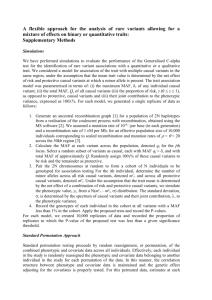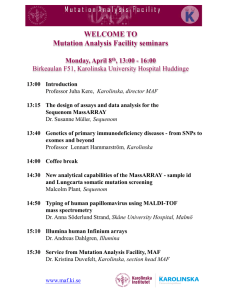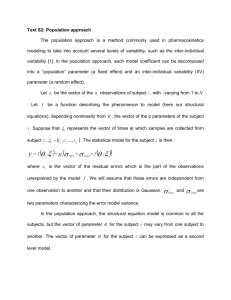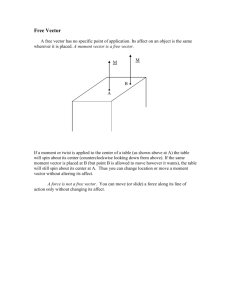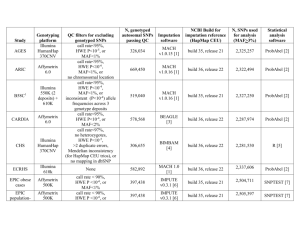file - BioMed Central
advertisement
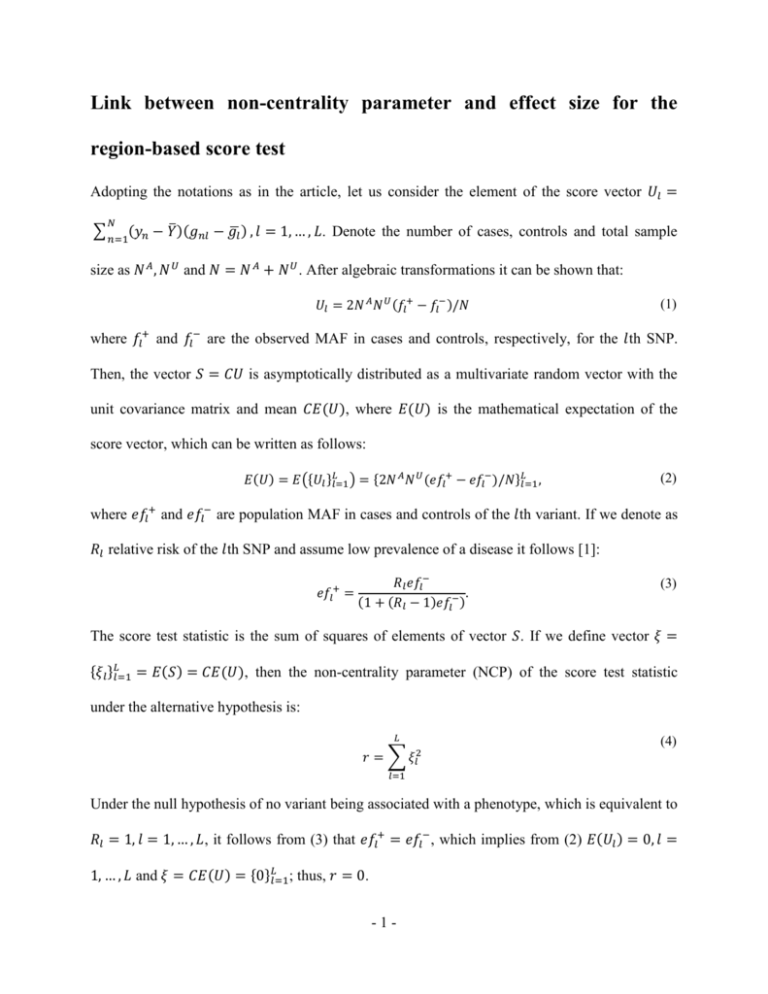
Link between non-centrality parameter and effect size for the
region-based score test
Adopting the notations as in the article, let us consider the element of the score vector 𝑈𝑙 =
𝑁
∑𝑛=1(𝑦𝑛 − 𝑌̅)(𝑔𝑛𝑙 − 𝑔̅𝑙 ) , 𝑙 = 1, … , 𝐿. Denote the number of cases, controls and total sample
size as 𝑁 𝐴 , 𝑁 𝑈 and 𝑁 = 𝑁 𝐴 + 𝑁 𝑈 . After algebraic transformations it can be shown that:
𝑈𝑙 = 2𝑁 𝐴 𝑁 𝑈 (𝑓𝑙+ − 𝑓𝑙− )/𝑁
(1)
where 𝑓𝑙+ and 𝑓𝑙− are the observed MAF in cases and controls, respectively, for the 𝑙th SNP.
Then, the vector 𝑆 = 𝐶𝑈 is asymptotically distributed as a multivariate random vector with the
unit covariance matrix and mean 𝐶𝐸(𝑈), where 𝐸(𝑈) is the mathematical expectation of the
score vector, which can be written as follows:
𝐸(𝑈) = 𝐸({𝑈𝑙 }𝐿𝑙=1 ) = {2𝑁 𝐴 𝑁 𝑈 (𝑒𝑓𝑙+ − 𝑒𝑓𝑙− )/𝑁}𝐿𝑙=1 ,
(2)
where 𝑒𝑓𝑙+ and 𝑒𝑓𝑙− are population MAF in cases and controls of the 𝑙th variant. If we denote as
𝑅𝑙 relative risk of the 𝑙th SNP and assume low prevalence of a disease it follows [1]:
𝑒𝑓𝑙+
𝑅𝑙 𝑒𝑓𝑙−
=
.
(1 + (𝑅𝑙 − 1)𝑒𝑓𝑙− )
(3)
The score test statistic is the sum of squares of elements of vector 𝑆. If we define vector 𝜉 =
{𝜉𝑙 }𝐿𝑙=1 = 𝐸(𝑆) = 𝐶𝐸(𝑈), then the non-centrality parameter (NCP) of the score test statistic
under the alternative hypothesis is:
𝐿
𝑟 = ∑ 𝜉𝑙2
(4)
𝑙=1
Under the null hypothesis of no variant being associated with a phenotype, which is equivalent to
𝑅𝑙 = 1, 𝑙 = 1, … , 𝐿, it follows from (3) that 𝑒𝑓𝑙+ = 𝑒𝑓𝑙− , which implies from (2) 𝐸(𝑈𝑙 ) = 0, 𝑙 =
1, … , 𝐿 and 𝜉 = 𝐶𝐸(𝑈) = {0}𝐿𝑙=1; thus, 𝑟 = 0.
-1-
Description of the assumptions for illustration of connection
between non-centrality parameter and effect size
From the considerations above, it can be seen that NCP 𝑟 is a function of the number of cases 𝑁 𝐴
and controls 𝑁 𝑈 in the study, relative risk of each variant 𝑅𝑙 , 𝑙 = 1, … , 𝐿; population MAF in
controls 𝑒𝑓𝑙− , 𝑙 = 1, … , 𝐿; and covariance matrix of the score test statistic 𝑉 (since matrix 𝐶 =
(𝐴𝑇 )−1 , where 𝑉 = 𝐴𝑇 𝐴). To illustrate the dependence between NCP and relative risk let us
assume independence of variants within the region, which implies the matrix 𝑉 is diagonal.
Thus, 𝑉 = 𝑑𝑖𝑎𝑔({𝑣𝑙 }𝐿𝑙=1 ) where 𝑣𝑙 = 𝑣𝑎𝑟(𝑔𝑙 ) is variance of the 𝑙th SNP in our sample. It
follows that 𝑣𝑎𝑟(𝑔𝑙 ) = 2𝑁 𝑈 (1 − 𝑒𝑓𝑙− )𝑒𝑓𝑙− + 2𝑁 𝐴 (1 − 𝑒𝑓𝑙+ )𝑒𝑓𝑙+ , which is variance of the sum
of two independent binomial random variables with the number of draws 2𝑁 𝑈 and 2𝑁 𝐴 and the
probability of success 𝑒𝑓𝑙− and 𝑒𝑓𝑙+ respectively. It follows:
C = 𝑑𝑖𝑎𝑔(1/√2𝑁 𝐴 (1 − 𝑒𝑓𝑙+ )𝑒𝑓𝑙+ + 2𝑁𝑈 (1 − 𝑒𝑓𝑙− )𝑒𝑓𝑙− , 𝑙 = 1, … , 𝐿).
(5)
So, given population MAF of causal variants in controls 𝑒𝑓𝑙− , relative risk of causal variants 𝑅𝑙 ,
the number of cases 𝑁 𝐴 and controls 𝑁 𝑈 , we can calculate the corresponding NCP 𝑟 according
to the following algorithm:
1. calculate 𝑒𝑓𝑙+ – population MAF in cases from (3)
2. calculate 𝐸(𝑈) – the expectation of the score vector 𝑈 from (2)
3. obtain matrix 𝐶 from (5)
4. calculate vector 𝜉 = {𝜉𝑙 }𝐿𝑙=1 = 𝐶𝐸(𝑈)
5. obtain NCP 𝑟 from (4).
For the purpose of illustration, let us assume 𝑁 𝐴 = 𝑁 𝑈 = 500, population MAF and relative risk
of all causal variants are equal. Additional File 7 depicts the non-centrality parameter (vertical
-2-
axis) as a function of relative risk (horizontal axis) and the number of causal variants (lines
within each panel). Population MAF of causal variants in controls was the following: Panel 1 –
1%, Panel 2 – 0.5%, Panel 3 – 0.25%, Panel 4 – 0.125%. As can be seen, the non-centrality
parameter monotonically increases with increasing relative risk, population MAF in controls and
the number of causal variants within a region.
References
1.
Sul JH, Han B, He D, Eskin E: An optimal weighted aggregated association test for
identification of rare variants involved in common diseases. Genetics 2011,
188(1):181-188.
-3-
